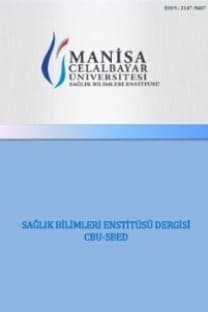Kronik Engelli Bireylerde Ortez Ve Yardımcı Cihaz Memnuniyetinin Araştırılması
Hasta memnuniyeti, Ortotik cihazlar, AFO, Tekerlekli sandalye
An Investigation Of Orthosis And Assistive Device Satisfaction In Individuals with Chronic Disabilities
Patient satisfaction, Orthotic devices, AFO, Wheelchair,
___
- 1. Bettoni E, G Ferriero, H Bakhsh, et al. A systematic review of questionnaires to assess patient satisfaction with limb orthoses, Prosthetics and Orthotics International, 2016, 40(2), 158-69.
- 2. Karaduman A, Yilmaz ÖT., Ortopedik Rehabilitasyon Pediatrik Rehabilitasyon; Pelikan Yayınevi: Ankara, Turkiye, 2016; pp 1079-138.
- 3. Demers L, M Monette, Y Lapierre, D Arnold, C Wolfson. Reliability, validity, and applicability of the Quebec User Evaluation of Satisfaction with assistive Technology (QUEST 2.0) for adults with multiple sclerosis. Disability and Rehabilitation, 2002, 24(1-3), 21-30.
- 4. Chen C-L, Y-L Teng, S-Z Lou, et al. User satisfaction with orthotic devices and service in Taiwan, PloS One, 2014, 9(10), e110661.
- 5. Basaran S, IC Benlidayi, PH Yigitoglu, N Gökcen, R Guzel. Actual use and satisfaction of lower extremity orthoses in neurological disorders, Turkish Journal Physical Medicine and Rehabilitation, 2016, 62(2),143-7.
- 6. Rackauskaite, Gija, et al. Impact of child and family characteristics on cerebral palsy treatment, Develoğmental Medicine and Child Neurology, 2015, 57(10), 948-954.
- 7. Erel S, IE Simsek, N Bek, et al. The effect of plastic foot-ankle orthosis appearance in childhood on satisfaction and orthosis acceptance, Turkish Journal of Physical Medicine and Rehabilitation, 2007, 18(3), 195-200.
- 8. Lee S-H. Users’ satisfaction with assistive devices in South Korea, Journal of Physical Therapy Science, 2014,26(4), 509-12.
- 9. Dilek B, G Gozde, Y Yakut. An investigation of the duration of ankle foot orthosis’daily usage in children withcerebral palsy: a pilot study, Journal of Exercise Therapy and Rehabilitation, 2015, 2(2), 47-52.
- 10. Peaco A, E Halsne, BJ Hafner. Assessing satisfaction with orthotic devices and services: a systematic literature review, Journal of Prosthetics and Orthotics, 2011, 23(2), 95-105.
- 11. Holtkamp F, E Wouters, J Van Hoof, Y Van Zaalen, M Verkerk. Use of and satisfaction with ankle foot orthoses, Clinical Research on Foot and Ankle, 2015, 3(1), 1000167.
- 12. Hovorka C, M Geil, M Lusardi. Orthotics and Prosthetics in Rehabilitation. 2nd edn. Oxford, Butterworth-Heinemann, 2007, pp 135-6.
- 13. Amosun S, A Ndosi, H Buchanan. Locally manufactured wheelchairs in Tanzania–are users satisfied, African Health Sciences, 2016, 16(4), 1174-81.
- 14. Magnusson L, G Ahlström. Patients’ Satisfaction with Lower-limb Prosthetic and Orthotic Devices and Service delivery in Sierra Leone and Malawi, BMC Health Services Research, 2017, 17(1), 102.
- 15. Bus SA, R Waaijman, F Nollet. New monitoring technology to objectively assess adherence to prescribed footwear and assistive devices during ambulatory activity, Archives of Physical Medicine and Rehabilitation, 2012, 93(11), 2075-9.
- 16. Maas JC, AJ Dallmeijer, BY Oudshoorn. Measuring wearing time of knee-ankle-foot orthoses in children with cerebral palsy: comparison of parent-report and objective measurement, Disability Rehabilitation, 2018, 40(4), 398-403.
- 17. Copley J, J Ziviani. Barriers to the use of assistive technology for children with multiple disabilities, Occupationl Therapy International, 2004, 11(4), 229-43.
- ISSN: 2147-9607
- Yayın Aralığı: Yılda 4 Sayı
- Başlangıç: 2014
- Yayıncı: Manisa Celal Bayar Üniversitesi Sağlık Bilimleri Enstitüsü
Eralp ÇEVİKKALP, Gülay OK, Koray ERBÜYÜN, Demet AYDIN, İdil TEKİN
Habil YÜCEL, Dilşad AMANVERMEZ ŞENARSLAN
SÜPERİOR PEDİKÜLLÜ RETROAURİKÜLER FLEP İLE KULAK SAYVANI DEFEKTLERİNİN ONARIMI
Yavuz KEÇECİ, Zülfükar Ulaş BALİ
Gebelikte Prenatal Bağlanma ve Vücut Algısı Arasındaki İlişki ve Etkileyen Faktörler
Tuba ÖZKAN, Didem ŞİMŞEK KÜÇÜKKELEPÇE, Semiha AYDIN ÖZKAN
Manisa’da 5-14 Yaş Arası Çocuklarda Enürezis Nokturna Sıklığı ve İlişkili Faktörler
Berna BİLGİN ŞAHİN, Pınar ERBAY DÜNDAR
Kronik Engelli Bireylerde Ortez Ve Yardımcı Cihaz Memnuniyetinin Araştırılması
TAMER ÇANKAYA, ALP ÖZEL, Seda AYAZ TAŞ, Demet KARABULUT, Sezen TEZCAN
Pain Management in Patients with Peripheral Arterial Disease
Buket ÖZYAPRAK, Kurtbey ANARAT, Mehmet GAMLI, Nail KAHRAMAN, Gönül ERKAN, Ahmet EROĞLU
Şadiye GÜNPINAR, Olgu ALPERAT KILIÇ, Mehmet TOSUN, Tülin FIRAT
Sezaryen Sonrası Benlik Saygısı ve Vücut Algısı
Aylin AYDIN SAYILAN, Ezgi SEYHAN AK, Ezginur İNAN, Ayşe KAVASOĞLU
Çağdaş Öykü MEMİŞ, BİLGE DOĞAN, Müge BULUT, Yaşan Bilge ŞAİR, Levent SEVİNÇOK
